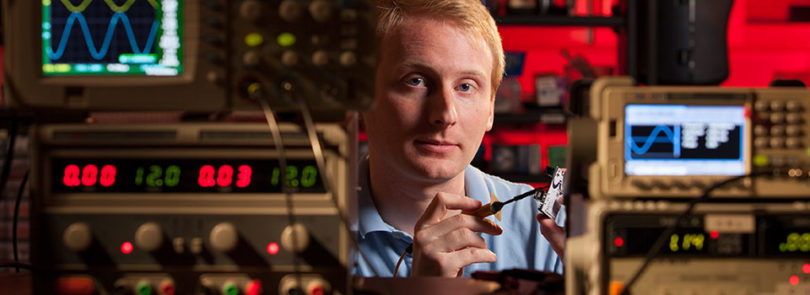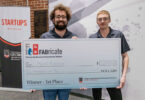To walk through the University of Georgia’s College of Engineering Medical Robotics Laboratory is to witness the inventive and synergistic play of the very, very bright. It is also a chance to witness “scenius,” a term coined by Brian Eno for the blending of creativity and science.
“When buoyed by scenius, you act like a genius. Your like-minded peers and the entire environment inspire you,” observes technologist Kevin Kelly.
In such an environment, magnetic resonance imaging-compatible medicine is made finer and better. The UGA lab’s website describes various MRI-compatible technologies under development, including the brain biopsy model, catheters, robotic prostate biopsy and electrocardiogram systems.
Stan Gregory, a doctoral student in engineering, spends his morning in the lab whenever he isn’t teaching, and sometimes when he is. He’s especially fond of bringing students into the lab to combine both experiences. In fact, he says he gets such a charge from this that he is now thinking of becoming an academic full time.
Young, lanky and energetic, Gregory transferred to UGA after completing his master’s at Virginia Tech. He completed his undergraduate studies at the University of North Carolina at Chapel Hill. Before coming to UGA, he was focused on impact biomechanics and bioinstrumentation.
For Gregory, who is surrounded by fascinating pieces of fabricated electronics and tools as he walks through the lab, that choice was specific and personal-not about the gadgetry. “It’s all about the adviser.” He headed to Georgia based upon one vital piece of information: the reputation of the lab manager, Zion Tse. Before transferring from Virginia, he visited the campus and interviewed the professor to confirm what he hoped-that Tse is a visionary who supports his students.
Tse previously worked for Harvard Medical School Brigham and Women’s Hospital, where he developed systems for cardiac MRI-guided catheter surgery, ECG and surgical navigation. Prior to coming to the United States, he developed a robotic system to perform prostate cancer biopsy under MRI guidance at the Imperial College of London’s Mechanical Engineering Department.
More recently, Tse was awarded UGA’s Innovative Instruction Grant for “Do-It-Yourself Approach for Learning Engineering Physiology.” Well-satisfied with their interview together, Gregory decided to finishing his graduate studies at Georgia. Tse says it is a pleasure to be his doctoral adviser.
“Stan is new to my lab, but he is undoubtedly a talented researcher,” says Tse, who also calls Gregory a mature student researcher “who will become a top-notch scientist in medical robotics.” Tse adds that “due to his strong training and practical experience in building ‘cool’ gadgets, Stan is our lab guru in electronics and he is passionate in helping people around him.”
The research of the UGA Medical Robotics Lab is devoted to MRI. MRI technology employs a high-powered magnet in order to construct two- and three-dimensional images that are much more detailed. Also, they are safer, as they do not use ionizing radiation.
“I think the best way to think about MRI is this,” Gregory explains. “Different parts of your body contain different amounts of water. The MRI magnetic field aligns the water molecules in your body so that they all point in the same direction, and then a pulse flips them in the opposite direction. The MRI then allows everything to relax; the water molecules flip back. Energy is released when this occurs. Different body parts with different amounts of water now release different amounts of energy. We can measure this energy if we get the timing right. The MRI more or less plots the energy levels over time to form an image. This is done over and over again to take images of your entire body.”
Unlike CT scans, MRI does not break DNA nor cause DNA mutations. Although human cell nuclei are affected, or excited, by the electromagnetic field of an MRI machine, all evidence is that they return to a normal state afterward. The challenge, however, is in constricting motion during a scan.
The physiologic motion of blood flowing through a heart creates problems when trying to create a still image through MRI. The pumping of the heart creates blurring on an image.
Gregory is working with MRI compatible signal processing techniques to address this problem. He specifically studies moving blood flow and imaging via MRI machine. There is also the need for speed-MRI is famously slow.
“Currently, I am studying methods to improve image quality and decrease scan time during cardiac MRI using electrocardiogram (recordings of the heart’s electrical activity) synchronization. This led me to further investigate certain noise sources that appear in these recordings caused by magnetic field interactions with patient blood flow (magneto hydrodynamic voltages). I work to understand the physiological significance behind these signals and translate them into tools for diagnosis of cardiovascular disorders.”
Today, the UGA lab maintains a relationship with Brigham and Women’s Hospital in Boston, through the hospital’s professional affiliation with Zion Tse. Brigham and Women’s Hospital is next door to Harvard Medical School and is their largest teaching affiliate.
During a lab tour, while explaining various lab projects presently underway by his fellow researchers, Gregory demonstrates a 3-D printer within the lab, which has been used to produce a variety of objects. It created the basis for a model, which fellow researcher Alex Squires is working with to help pinpoint the exact location of tumors in veterinary medicine.
As lab manager, Squires says, “I was the first hire of the new lab in May 2012.” He is a native of Richmond Hill, Ga., and received a Foundation Fellowship during his senior year as a UGA undergraduate.
Like Gregory, he prefers high interaction with students and fellow researchers. For fun, he advises the Athens Academy robotics team on fabrication and design.
Squire’s adviser, Tse, says in praise, “Both Alex and Stan are among the top 1 percent of students I have met in my academic career.”
He describes with pride how Squires was profiled as an “amazing student” on the university’s website, and how he has become involved in the larger community.
“Besides his research, Alex is a pro bono robotics teacher in Athens academia, being involved in outreaching school students for STEM education. He is well-connected to
LEGO education due to his passion in LEGO, and he has set up a good connection between our lab and LEGO education in Atlanta. Alex has the quality to become a well-rounded professor and an amazing teacher,” Tse wrote while attending a conference. Squires volunteers as a judge for Odyssey of the Mind and the First LEGO League. The First Lego League pairs children and an adult coach with the challenge of building LEGO robots. If the effort works, it will serve to interest them in science.
Kelly describes the aspects of scenius, from mutual appreciation, rapid exchange of tools and techniques, and network effects of success. A fourth aspect of scenius, Kelly said, is a “local tolerance for novelties.” This means, he says, the creative group looks after one another, creating a buffer against conformity. Inside this “beaker” he says “strange reactions are allowed to take place.”
Inside such a place like the Medical Robotics Lab, better medicine-faster, safer-can evolve.
On the lab’s website, Squires’ project is described as a localizer box “made MRI compatible with a GE 3T MRI scanner, allowing the box to hold the subject’s head inside an MRI head coil during scanning while maintaining the same coordinate framework for subsequent needle therapy in the brain.” Officially, it is a stereotactic frame design for MRI-guided needle therapy in brain procedures.
Here again, the old enemy of imaging and proton beam radio therapy is motion.
“Physiological motion-of arteries, or the patient moving, breathing or stretching, is the enemy. To have it fixed is extremely important. You can imagine if they are going for the brain,” says Phillips. “This idea of Squires’ is an interesting, creative idea. If you image the patient and make a custom brace, then the dog, or the child, buys their custom “box”-then whatever intervention they do is going to be precisely focused … this is much more refined.”
Squires is now collaborating with doctors at Emory University to develop a tool to more precisely apply therapeutic stem cells into the spines of Lou Gehrig patients.






